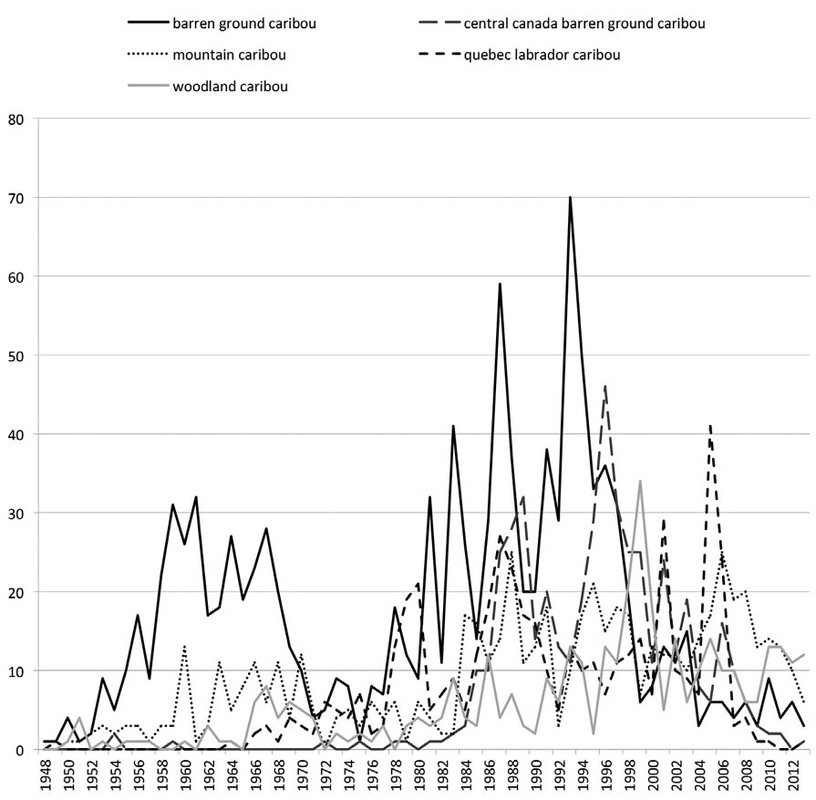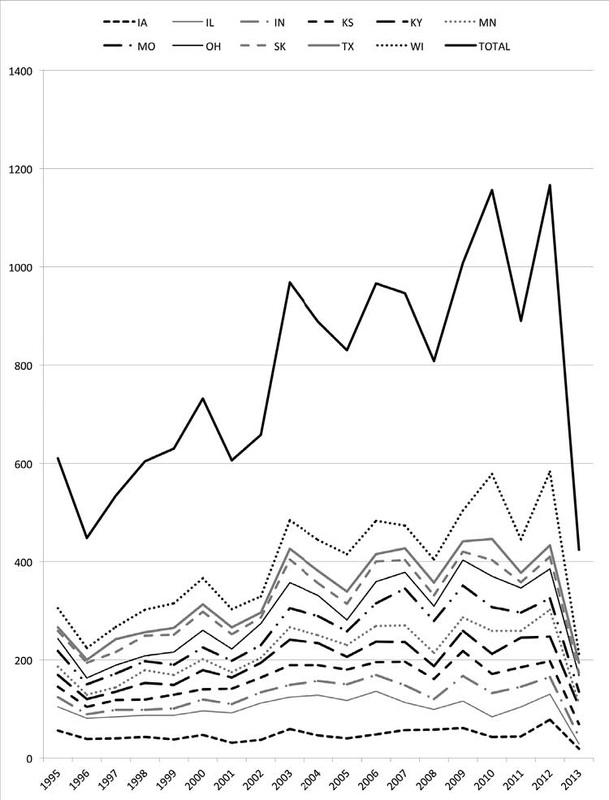Boone and Crockett Club’s records-keeping system dates back to 1949 when a Boone and Crockett Club committee was tasked with developing a scoring method to rank North American trophies. Prior to that, trophies were recorded and the top entries were invited to a competition, but the judging was highly subjective. While this was appropriate during a time of very few mature specimens, as wildlife populations began to rebound, it became readily apparent that records must be standardized if they were to remain relevant in the battle for wildlife conservation.
The system implemented in 1950 is still used today by B&C, along with a very long list of other national groups from the Pope and Young Club to dozens of state scoring associations across the country. While it’s enjoyable to compare trophies with hunting companions, the basis of this system lies in the recording of mature specimens from all categories of native North American big game. The idea of recording only mature males taken within the rules of fair chase is twofold. First, it incentivizes hunters to be selective and to ensure their take is not leading to the overconsumption of the resource. Selective hunting takes pressure off immature and female members of the species—which, at the time the system was developed, was paramount to facilitating the recovery of North American big game. The second is the promotion of an ethic to which hunters could hold themselves accountable, ensuring consumption of the resource is not overindulgent.
Several questions arose as B&C established a set of rules to help guide hunter preference. How do we gauge wildlife populations through the data collected through our records? What do the details of the measurements take into account, and how is the data useful?
The idea of records keeping and the reason we continue their collection today is their use as a data set of all North American big game. Nearly all agencies keep records of population estimates, hunter densites, etc. While this data is useful in state management, it does not provide a snapshot of the entire continent’s game populations. Realizing this is the goal of Boone and Crockett Club, the question becomes, How do you keep a data set to gauge populations of 32 big game species across an area of over 9.5 million square miles? Herein lies the part of the system that is most greatly misunderstood. If we gauge trophies that have passed their prime breeding age and exhibit certain characteristics of a very mature animal, we can gauge wildlife health on a continental scale. We can identify regions of the continent either succeeding or failing by comparing entry rates with hunter numbers and availability. This threshold of mature specimens exhibiting only the strongest normal traits of the species is where B&C sets its minimum scores for each category. While you would never think so by observing outdoor media today, a typical whitetail deer scoring 160 inches carries just as much value as a data point as the next World’s Record. People get so hung up on the abnormal and final number, they lose sight of the score as a measure of wildlife population health and not that of their prowess as a hunter.
For example, a typical whitetail deer, to be considered a prime, mature animal, must exhibit antlers with 160 inches of mass, beam lengths, tine lengths, and spread. In order for this to happen, the deer must be allowed not only the minimum requirements for survival, but also additional nutrition and prime habitat to exhibit that 160 inches of antler. Antlers are a secondary sexual characteristic, meaning they are expressed in males to show their reproductive value and to compete for breeding rights. Antlers develop after survival requirements are met. For this to be achieved, the specimen must have all the required nutrient intake, mineral availability, habitat suitability, and so on. A buck will be unable to reach the minimum score if an area has an overpopulation of deer and/or browse is limited—and therefore, the nutrition to create additional antler is not available. If an area produces none or very few mature specimens, this points to a habitat or population problem and is cause for further investigation.
Some variations in entry rates are easily explainable. If you look at the upper Midwest, there appears to be a good gradient that in most cases does not halt at a state line. Should this happen, it would suggest that perhaps the state where the density increases or decreases is doing something differently to manage the game. State lines are arbitrary boundaries created by humans and variations in trophy density between neighboring states are nearly always attributed to differing management strategies.
Examining historical versus more recent data can also be used in gauging herd health and also gauging effects of major changes such as illegal harvest, changing predator management regulations, or an increase or decrease in tag numbers.
While most species are doing well, there are a few that are not; for example, the various caribou species. There are some successes and failures, but overall trophy entries are down. Lowering the minimum entry score has been discussed, although this creates a false sense of quality habitat. If caribou used to be larger, we must not resign ourselves to smaller caribou; instead we should throw our resources at discovering what is causing population declines. We see mountain caribou still doing well. It is mainly the migratory herds that we are seeing drop in numbers of trophy entries. Without a national comparison, individual investigations into the decline in particular areas may miss this fact or others that the scientific community has yet to identify.

Photo credit Boone & Crockett Club
A second interesting analysis is that of the whitetail. After decades of continual increases we finally peaked and saw major declines across the country in the 2013 season. Every year, deer shows in Iowa, Illinois, and Wisconsin display the top heads from the year’s hunt. All of them were down in trophies. Each individual state could point to management failure, predation, or a laundry list of other factors, but only B&C has the data to do an in-depth analysis of whitetails across their entire range. Midway through the calendar year, the drop is slightly exaggerated since we usually receive entries through the following season, but something happened on a national scale that dropped entries significantly. This decrease is being investigated on numerous levels, and the conclusions are yet to be formulated. However, I hope you can see by now that our data set is maintained specifically for this type of analysis.
Boone and Crockett Club’s records program is always trying to expand the data we collect in order to produce a more viable data set for both wildlife managers and sportsmen as well as other wildlife enthusiasts. Our most recent undertakings involve a ramped-up effort to obtain trophy age data. For some species such as the bighorn sheep, trophies are aged by experienced biologists when they are checked in after harvest. This gives us the ability to analyze age versus score in different regions. If a particular area produces 190-inch bighorns at age 6, such as the Missouri Breaks, or it takes 10-plus years to reach that maturity, as we commonly see in Alberta, we can compare habitats and see what factors allow this excessive growth at a young age not seen in other locations.
While this may be interesting for a hunter selecting a location to pursue bighorns, it has much further-reaching consequences. A study was completed in Canada where they documented a decrease in horn size relative to the age of the rams harvested. This was ultimately attributed to hunter selection. This particular area has a ram mortality of 100 percent once they reach legal minimum size. It is a very small, isolated population that is extremely accessible with no limit on tags. I don’t foresee this example taking place in most sheep populations—as harvest is extremely limited and highly monitored—though it showed that under intense harvest, mean horn size decreased.
The question becomes, Are other areas experiencing this side effect of trophy selection? The only way to truthfully sort this out is to put together a strong age data set. If an area produced elk that scored 375 points at age 7 and now they don’t reach 360 points until age 9, we know that population health or habitat quality has degraded. Other contributing factors could include predation, which can prevent animals from consuming and converting nutrients to antler, as well as hunters altering selection by harvesting the larger trophies at a level that pushes smaller bulls that produce smaller racks into the main breeding position. The way to determine if this is the case is to attach an age to the antler or horn score. As hunters, we do not want to harm a population or alter genetic selection; rather, harvest the surplus for our use while allowing the species to thrive.

Photo credit Boone & Crockett Club
This idea that the records data are for wildlife health and not the hunter’s ego is the most important aspect to stress when explaining why we keep records. Records are maintained as a tool to gauge wildlife management successes and failures. In order to create successful estimates, we must receive a high portion of qualifying trophies—be it picked-up heads or trophies taken by any means from archery to rifle, or road kills. In order for this data set to be valid, it falls to the hunter to enter his or her trophy to ensure the opportunities we are afforded today are there for future generations.
The next time you are sitting around camp and a hunting buddy starts in about all the records book-qualifying heads he has but doesn’t care about the score, inform him of the purpose of the records: it has nothing to do with chest pounding and everything to do with species conservation. There isn’t a hunter out there who thinks the wildlife management authority in charge of their particular area is not making mistakes. B&C records are a way to call hunters to task on this.
This is the dataset completed by people on the ground; these are the results of public hunting of public wildlife ensured through the North American Model for Wildlife Conservation.
These records are the report cards for which we all must be held accountable regardless of our personal selection or desire to be listed in “the book.”
Justin Sprigg
B&C Assistant Director of Big Game Records
As Written In Big Trophies, Epic Hunts

